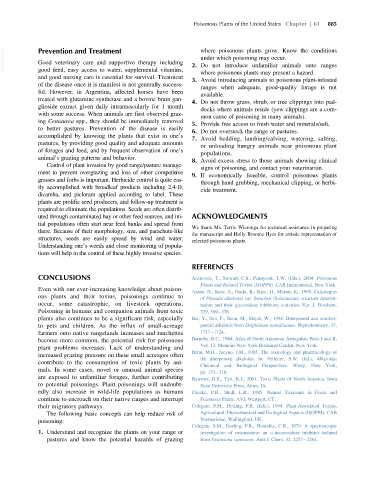Page 933 - Veterinary Toxicology, Basic and Clinical Principles, 3rd Edition
P. 933
Poisonous Plants of the United States Chapter | 61 885
VetBooks.ir Prevention and Treatment 2. Do not introduce unfamiliar animals onto ranges
where poisonous plants grow. Know the conditions
under which poisoning may occur.
Good veterinary care and supportive therapy including
good feed, easy access to water, supplemental vitamins,
where poisonous plants may present a hazard.
and good nursing care is essential for survival. Treatment
3. Avoid introducing animals to poisonous plant-infested
of the disease once it is manifest is not generally success-
ranges when adequate, good-quality forage is not
ful. However, in Argentina, affected horses have been
available.
treated with glutamine synthetase and a bovine brain gan-
4. Do not throw grass, shrub, or tree clippings into pad-
glioside extract given daily intramuscularly for 1 month
docks where animals reside (yew clippings are a com-
with some success. When animals are first observed graz-
mon cause of poisoning in many animals).
ing Centaurea spp., they should be immediately removed
5. Provide free access to fresh water and minerals/salt.
to better pastures. Prevention of the disease is easily
6. Do not overstock the range or pastures.
accomplished by knowing the plants that exist in one’s
7. Avoid bedding, lambing/calving, watering, salting,
pastures, by providing good quality and adequate amounts
or unloading hungry animals near poisonous plant
of forages and feed, and by frequent observation of one’s
populations.
animal’s grazing patterns and behavior.
8. Avoid excess stress to those animals showing clinical
Control of plant invasion by good range/pasture manage-
signs of poisoning, and contact your veterinarian.
ment to prevent overgrazing and loss of other competitive
9. If economically feasible, control poisonous plants
grasses and forbs is important. Herbicide control is quite eas-
through hand grubbing, mechanical clipping, or herbi-
ily accomplished with broadleaf products including 2,4-D,
cide treatment.
dicamba, and picloram applied according to label. These
plants are prolific seed producers, and follow-up treatment is
required to eliminate the populations. Seeds are often distrib-
uted through contaminated hay or other feed sources, and ini- ACKNOWLEDGMENTS
tial populations often start near feed bunks and spread from
We thank Ms. Terrie Wierenga for technical assistance in preparing
there. Because of their morphology, size, and parachute-like
the manuscript and Holly Broome Hyer for artistic representation of
structures, seeds are easily spread by wind and water.
selected poisonous plants.
Understanding one’s weeds and close monitoring of popula-
tions will help in the control of these highly invasive species.
REFERENCES
CONCLUSIONS Acamovic, T., Stewart, C.S., Pennycott, T.W. (Eds.), 2004. Poisonous
Plants and Related Toxins (ISOPP6). CAB International, New York.
Even with our ever-increasing knowledge about poison-
Asano, N., Kato, A., Oseki, K., Kizu, H., Matsui, K., 1995. Calystegins
ous plants and their toxins, poisonings continue to of Physalis alkekengi var. francheti (Solanaceae): structure determi-
occur, some catastrophic, on livestock operations. nation and their glycosidase inhibitory activities. Eur. J. Biochem.
Poisoning in humans and companion animals from toxic 229, 369 376.
plants also continues to be a significant risk, especially Bai, Y., Sun, F., Benn, M., Majak, W., 1994. Diterpenoid and norditer-
to pets and children. As the influx of small-acreage penoid alkaloids from Delphinium nuttallianum. Phytochemistry. 37,
farmers onto native rangelands increases and ranchettes 1717 1724.
become more common, the potential risk for poisonous Barneby, R.C., 1964. Atlas of North American Astragalus: Parts I and II,
plant problems increases. Lack of understanding and Vol. 13. Memoirs New York Botanical Garden, New York.
Benn, M.H., Jacyno, J.M., 1983. The toxicology and pharmacology of
increased grazing pressure on these small acreages often
the diterpenoid alkaloids. In: Pelletier, S.W. (Ed.), Alkaloids:
contribute to the consumption of toxic plants by ani-
Chemical and Biological Perspectives. Wiley, New York,
mals. In some cases, novel or unusual animal species
pp. 153 210.
are exposed to unfamiliar forages, further contributing Burrows, G.E., Tyrl, R.J., 2001. Toxic Plants of North America. Iowa
to potential poisonings. Plant poisonings will undoubt- State University Press, Ames, IA.
edly also increase in wild-life populations as humans Cheeke, P.R., Shull, L.R., 1985. Natural Toxicants in Feeds and
continue to encroach on their native ranges and interrupt Poisonous Plants. AVI, Westport, CT.
their migratory pathways. Colegate, S.M., Dorling, P.R. (Eds.), 1994. Plant-Associated Toxins,
The following basic concepts can help reduce risk of Agricultural, Phytochemical and Ecological Aspects (ISOPP4). CAB
poisoning: International, Wallingford, UK.
Colegate, S.M., Dorling, P.R., Huxtable, C.R., 1979. A spectroscopic
1. Understand and recognize the plants on your range or investigation of swainsonine: an α-mannosidase inhibitor isolated
pastures and know the potential hazards of grazing from Swainsona canescens. Aust J. Chem. 32, 2257 2264.

